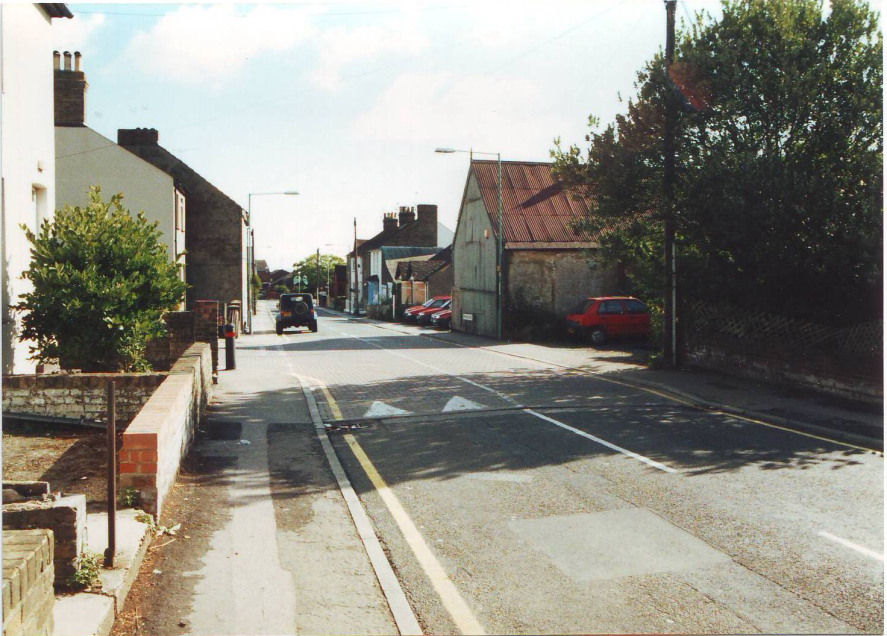Two of the older buildings in Orchard Street were vacated as furniture stores at the end of July by Lukehursts who have acquired new facilities at Sittingbourne. Both were erected over one hundred years ago and were very important to residents during the intervening period. The rather dilapidated eyesore opposite Thames Avenue was purchased by the Kent County Council over thirty years ago to protect the line of the anticipated Rainham Bypass which has now been cancelled and I presume that the buildings will now be demolished and the land used for housing.
The original building on site was solely that small section at the northern corner with a wooden frontage bordering upon the pavement. It was mainly corrogated iron, a material which was so popular and serviceable for many utility buildings before asbestos became available. The more permanent buildings to the rear were added piecemeal post war. I believe Cartiers, the Kent superstore firm used it before, Candy and then Lukehursts, all for storage purposes. It may be difficult to appreciate but for 43 years from February 1911 it was home to the Freemason’s Rochester Lodge and I have been fortunate to be loaned a short history of the lodge written by Wally Russell who died recently. Wally records that meals after the early meetings were taken at The Lion (not Green Lion then) when the cost for 30 was (10 pence) each plus whisky at 25 pence a bottle. Wally mentions that the only heating was by a Tortoise stove (similar to the large black free standing ones we had in the old schools) and on arrival for a rather important meeting the room was full of smoke as birds had built nests in the chimney and their guests had to be occupied elsewhere until the smoke was cleared.
Apparently some of the members were Officers from the RE barracks at Brompton and as trams ceased early in the evening many had to walk home. The Lodge eventually moved to the vacant Methodist Church in Ivy Street in May 1954. The false ceiling of the old building has a golden five pointed Star of David with a smaller star attached so I thought that perhaps the building may have been erected or used for religious purposes before 1911. The 1908 Kelley’s directory shows it used by Harvey’s School but I have failed to find any recorded use before that date. The other building now likely to be converted into two flats is the Provident Baptist Chapel which has a plaque outside showing that it was erected in 1884 with an internal wall tablet recording that it was built ‘in affectionate remembrance of Thomas Stanley Wakeley, pastor of this Parish who for 28 years preached to this Church and congregation. Died 27th May 1899’.
Obviously the members met elsewhere before 1884 and I just wonder if they may have built or worshipped in the corrugated iron building a few yards up the road. The Wakeley family had a great influence upon the life of the village around the turn of last century, they farmed hundreds of acres employing a large number of residents in various capacities, both male and female, full and part time. The main employment was agriculture, brick and cement making, all highly labour intensive. The various branches of the Wakeley family resided in some of the largest houses. Mr Seymour Wakeley lived at ‘The Limes’ in Broad Walk (now gone), Mr Richard Mansfield Wakeley and Joseph resided at Moor Street House on the corner of Seymour Road (then called Wakeley Lane) even though Wakeley Road had been opened up off Station Road. In fact it is also shown on maps of that period as Moor Street Lane so it has had at least three names but fortunately no residents were seriously inconvenienced.
Mr William Wakeley lived at Macklands House now part of the sheltered house complex in Station Road. The member of the family known nationally was Sir Cecil Wakeley KBE CB FRCS, who, having served in the Navy during the first war became a Surgeon Rear Admiral in the second. He held the illustrious position as President of the Royal College of Surgeons from 1949 to 1954, and at one time lived in Maidstone Road, Chatham. I understand that his son William now resides in Hartlip. I hope, with the co-operation of a member of the family, to write more about the history of the Wakeley family in due course.
Rainham was described at the turn of the century as a ‘populace village and parish comprising 3,562 acres of land with a population in 1901 of 3,693 (887 children in four schools including 80 in the Lower Rainham National School). Among the religious organisations mentioned is the Original Peculiar People who met at ‘Meeting House Chapel’ situated about halfway along William Street on the southern side. I wonder if the present residents know of its history, I suppose that some of our present citizens must be descendants of its members!
Freddie Cooper


